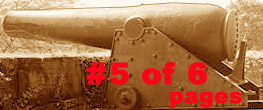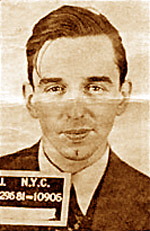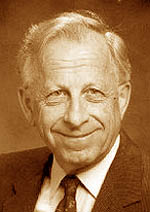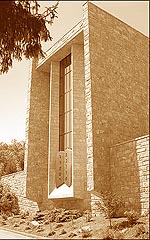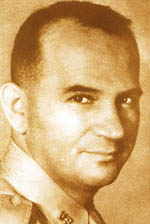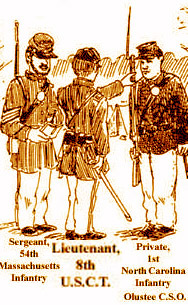|
Alcatraz, in San Francisco Harbor, was its western counterpart. The difference between the two sites being, among other things, that Alcatraz became a federal prison after being military, and Castle Williams didn't. By World War II, it was seen as being too vulnerable, particularly if really dangerous prisoners were housed there. So it was converted to a lower-level incarceration facility. Indeed, William Colepaugh and Erich Gimpel, the two spies captured about a month after they had come ashore at Frenchman's Bay, Maine, from a German submarine on Nov. 30, 1944, were held in custody elsewhere before their 8-day trial on Governor's Island. Convicted and sentenced to be hanged, implementation of the sentence was postponed due to the death of President Franklin D. Roosevelt, the subsequent weeks of official mourning, and then the end of the war in Europe. Imprisoned at Fort Jay, the two awaited word on their fate. Eventually President Harry S. Truman computed their death sentences to life in prison but ultimately even that was reduced. Colepaugh, an American defector, served 15 years in Leavenworth. Gimpel served 10 years in Attica prison and then was deported to Brazil. Unlike six earlier captured WWII German spies sentenced to death, Colepaugh and Gimpel had survived. The earlier six were executed after the U.S. Supreme Court -- in an opinion delivered for the court by Chief Justice Harlan Fiske Stone in EX PARTE QUIRIN, 317 U.S. 1 (1942) -- upheld the FDR-established military commission process by which they were tried, convicted and sentenced. It was in this opinion that, as cited earlier in this web presentation, the case of Confederate spy John Y. Beall, executed on Governors Island, was so succinctly summarized. Interest in the Stone court decision of 1942 regarding military commissions trying spies and saboteurs has heightened in the wake of 9/11. The island use for prison purposes ended when the Army left in 1966.
The year 1966 also figures in the story of a chapel far up the river from Governors Island, a tale worth the telling here even if the connections are somewhat tangential. Part of the story can be found in the text of a guest sermon given on July 9, 1999, by Col. Merton Singer on Armed Forces Sabbath about “The Founding of the Jewish Chapel at West Point.”
Three decades later as the commanding officer of Governors Island and, coincidentally President of the West Point Society of New York, an alumni organization, Singer was in a good position to rectify the situation. Col. Singer and three fellow alumni “got together and decided that the time had come to build a Jewish cadet chapel at West Point, which I had dreamed about for 27 years while on active duty. Since I was, at that time, a trustee of the Military Academy and well known in military and New York civilian circles, the other three felt that I should assume the presidency of the West Point Jewish Cadet Chapel Committee. The purpose of the committee was not only to commence raising funds, but also to procure the approval of the West Point superintendent and the Department of the Army to build the chapel. The superintendent of the Military Academy, LTG Donald Bennett, was understanding. . . . He selected a magnificent site high on a hill on the same level as the Protestant and Catholic chapels. . . . Both Jews and Christians, graduates and non-graduates, served on the Fund Raising Committee. Fifteen years later, all the funds were raised and the chapel completed. . . .” In 1966, even as the drive that had been initiated by Governors Island commanding officer Singer to build the West Point Jewish Chapel continued despite the Army's pullout from the island, the American Veterans of Israel began holding annual memorial services for a West Point graduate and former Governors Island officer who after WWII lost his life while serving as a general in the Israeli army. His listed name on the Israeli military roster was “Michael Stone,” an alias adopted for reasons of state. Prior to becoming “Michael Stone”, he had been a highly-placed U.S. military aide involved in setting up the United Nation that had sanctioned establishment of an Israeli state. He also had played a significant role in post-liberation work at Nazi death camps and in planning legal and security procedures for the Nuremberg trials. His actual name: David Marcus. David, better known as “Mickey,” entered the U.S. Military Academy in 1920, when Brig. Gen. Douglas MacArthur was superintendent. After Marcus graduated in 1924 as a second lieutenant of infantry, his first assignment was on Governors Island. While there he began studying law nights at Brooklyn Law School, commuting by ferry. While Governors Island was still his duty assignment, Mickey married Emma Hertzenberg in 1927. After service in Puerto Rico, Marcus resigned his regular commission and went to work as a law clerk in New York City. Thus began a law and public service career that included several years as the virtual and then actual NYC Correction Commissioner. But in 1940 with U.S. entry into WWII imminent, Marcus resigned as Correction Commission to return to the military. He was promoted to Colonel in 1943. His WWII service – that included volunteer parachuting in the D-Day invasion at Normandy (despite no parachute training) – earned him various decorations including the Distinguished Service Cross. In 1947, once again a civilian, Marcus was approached by representatives of Israeli independence movement. Having been at Dachau soon after its liberation (a liberation that did not come soon enough for the bodies he saw piled high there), Mickey felt he could not refuse.
As a former Correction Commissioner, Marcus was well aware that prisons and detention facilities are difficult environments at best, but Dachau evidenced evilness personified. It was a perversion, an obscenity, a criminal desecration against all humanity. In that context, he saw his serving in the Israeli Defense Force as an opportunity to make a meaningful stand for human decency and justice, and against all the Dachaus of the world. Strong on military, organizational and leadership skills, but weak on his knowledge of Hebrew, his outstanding service as Supreme Commander of the Israeli forces at Jerusalem ended June 10, 1948, when his password response to a challenge from nervous Israeli sentry proved fatally unsatisfactory. His is the only grave in the U.S. Military Academy Cemetery of a West Pointer who died fighting under a foreign flag. The tombstone inscription reads: “Col. David Marcus -- A Soldier for All Humanity.”
The 39th annual Marcus Memorial took place Sunday, May 15, 2005, at the cemetery and the chapel. It ended with the playing of "Taps," the score of which -- being a bugle call -- would not have been in The Drummer's and Fifer's Guide by Drum Major George B. Bruce, Principal Instructor of the School of Practice for U.S.A. Field Musicians on Governor's Island.
Modifying the traditional camp "Lights Out" call, the general -- who could not read or write music - whistled the notes and his bugler Oliver Wilcox Norton did the musical notations. Although use of the Butterfield's Taps spread quickly among Union regiments and eventually became a regulation Army bugle call after the Civil War, all that came too late for it to be included in the Governors Island field music school instructor's book published in 1862.
By a special exception Army order, Butterfield -- who never attended West Point -- was buried in its cemetery. His is one of the most ornate monuments. There, at the end of every burial or memorial service, the haunting notes of his Taps float and echo through the air over all the simple grave markers and all the impressive monuments of officers from so many U.S.-fought wars . . . and one Israeli war. The opening of Governors Island National Monument park to the public, scheduled June 2005, means that occasions for memorial and patriotic ceremonies are likely to arise from time to time. So the 24 moving notes of former NY Harbor Commander Butterfield's Taps are likely to be heard there again.
|
 |
 |
 |
 |
 |
Click red-letter page number in top frame above or here below to access that page:
|
|
| |||||
|
|
|
|
|
|
|
| To Civil War & Correction menu. | ||
 © NYCHS reserves and retains all rights to the text other than quoted excerpts. Non-commercial educational use permitted provided NYCHS and/or its web site -- www.correctionhistory.org -- credited as the source.
© NYCHS reserves and retains all rights to the text other than quoted excerpts. Non-commercial educational use permitted provided NYCHS and/or its web site -- www.correctionhistory.org -- credited as the source.
Associate Professor Jannelle Warren-Findley of the Department of History of Arizona State University is researching Governors Island's history for a National Park Service project. Information sent to webmaster@correctionhistory.org that might be helpful to her research will be forwarded to her. Or send the information directly to the e-mail address listed on her Arizona State University Dept. of History faculty page. See Page 6 for listing and links of the scores of on-line sources of Governors Island information and images used in this presentation. --- Tom McCarthy |
